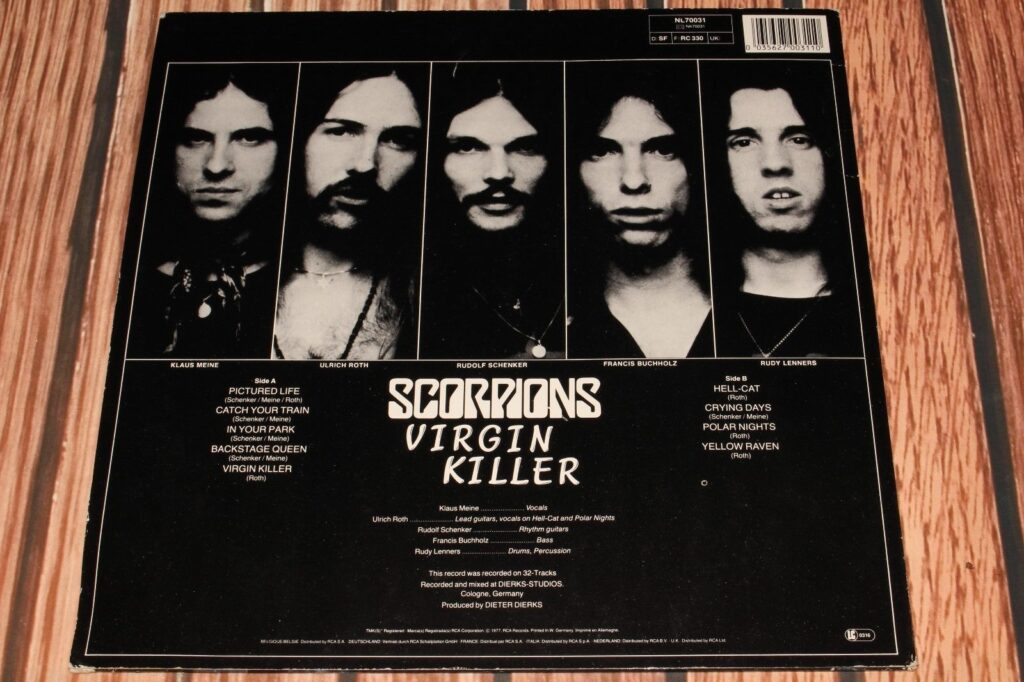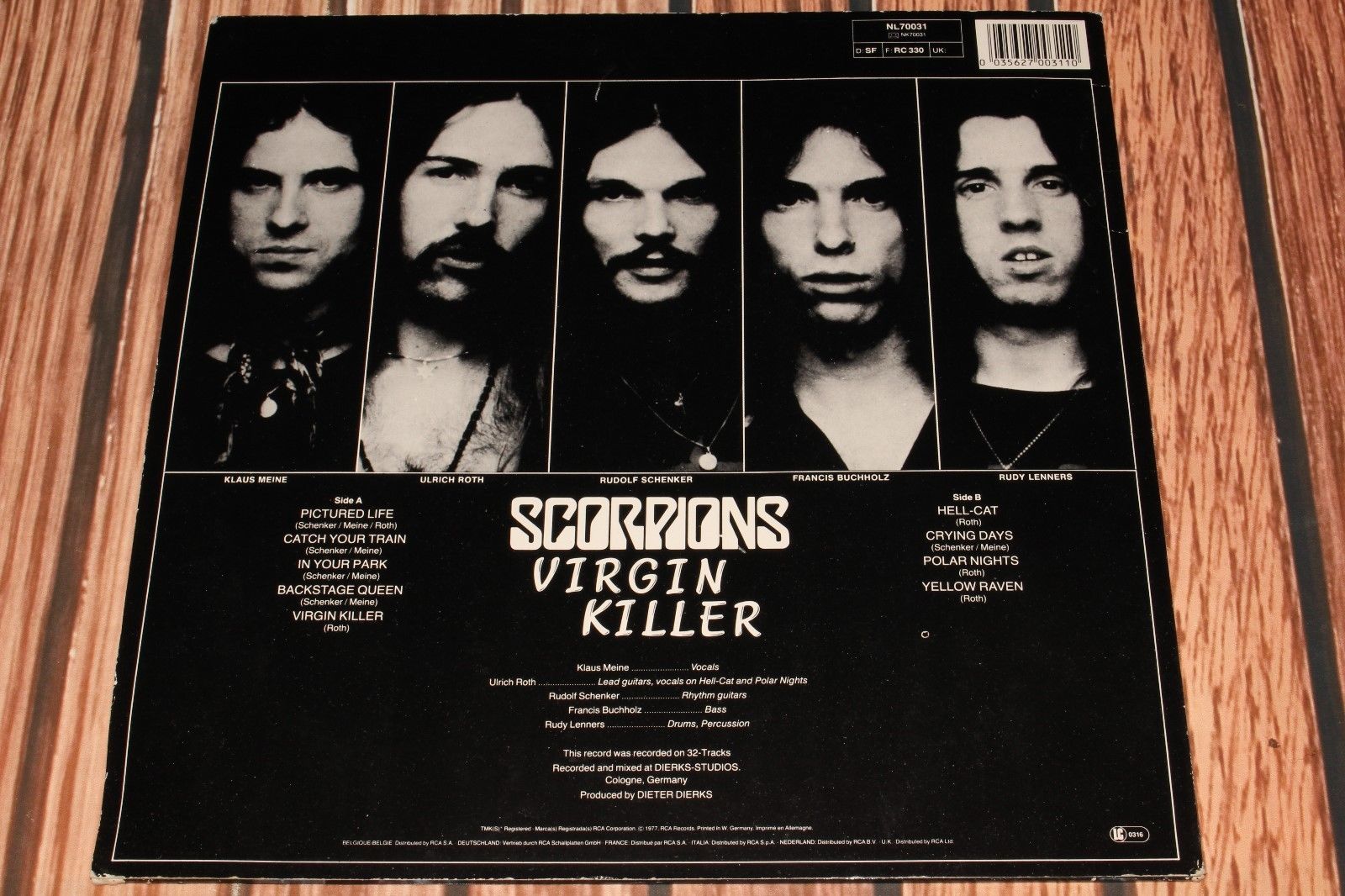
Introduction: The Virgin Killer Cover – A Scandalous Icon
The world of rock music is rife with iconic album covers, images that have become synonymous with the music they represent and etched into the collective cultural consciousness. Among these, few are as controversial and instantly recognizable as the cover of the Scorpions’ 1976 album, ‘Virgin Killer.’ This article delves deep into the history, context, and impact of this infamous album cover, exploring the reasons behind its creation, the ensuing outrage, and its lasting legacy within the music industry.
The ‘Virgin Killer’ cover has sparked debates about censorship, artistic expression, and the exploitation of children. Understanding the complexities surrounding this imagery requires a nuanced approach, considering the socio-political climate of the time and the band’s intentions, as well as the powerful reactions it provoked.
The Scorpions: A Brief History Before ‘Virgin Killer’
Before the storm of controversy, the Scorpions were a hard-rock band steadily building their reputation in the European music scene. Formed in Hanover, Germany, in 1965, the band initially consisted of Rudolf Schenker, Karl-Heinz Vollmer, and Wolfgang Dziony. Over the years, the lineup evolved, with Klaus Meine joining as the vocalist and becoming an integral part of the band’s signature sound.
By the mid-1970s, the Scorpions had released several albums, including ‘Lonesome Crow’ (1972), ‘Fly to the Rainbow’ (1974), and ‘In Trance’ (1975). These albums showcased their developing hard rock style, characterized by powerful riffs, soaring vocals, and a growing international fanbase. However, it was ‘Virgin Killer’ that catapulted them into the global spotlight, albeit for reasons they likely hadn’t fully anticipated.
The Genesis of Controversy: Designing the ‘Virgin Killer’ Cover
The original ‘Virgin Killer’ album cover featured a photograph of a nude pre-pubescent girl. The image, suggested by the record company, RCA, was intended to be a provocative statement, a play on the album’s title and a reflection of the themes explored within the music. However, the choice of imagery was immediately met with widespread condemnation.
The artwork was created by a design team at RCA Records, and the photograph was reportedly of a family member of someone involved in the album’s production. The intention, according to some accounts, was to shock and challenge societal norms surrounding sexuality and innocence. However, the execution proved deeply problematic, crossing the line into what many considered child exploitation and pornography.
The Band’s Perspective: Intentions and Regrets
The Scorpions have consistently maintained that they did not intend to exploit or sexualize a child. They claim that they were presented with the artwork by RCA and, perhaps naively, approved it without fully grasping the potential consequences. In subsequent interviews, band members have expressed regret over their decision, acknowledging the harm and offense caused by the cover.
Rudolf Schenker, the band’s guitarist and founding member, has stated that they were young and inexperienced at the time and did not fully understand the implications of the imagery. Klaus Meine, the vocalist, has echoed these sentiments, expressing remorse for the pain the cover caused and emphasizing that it was never their intention to promote child pornography.
The Immediate Backlash and Censorship
The release of ‘Virgin Killer’ sparked immediate and intense backlash from the public, media, and child protection organizations. The album was quickly banned or recalled in several countries, including the United States and the United Kingdom. Retailers refused to stock the album, and radio stations refused to play its music.
The controversy surrounding the cover overshadowed the music itself, hindering the album’s commercial success and damaging the band’s reputation. The Scorpions found themselves at the center of a public outcry, facing accusations of promoting child pornography and exploiting children for commercial gain.
In response to the widespread condemnation, RCA Records quickly withdrew the original cover and replaced it with an alternative image featuring a photograph of the band members. However, the damage had already been done, and the ‘Virgin Killer’ cover remained etched in the public consciousness as a symbol of controversial and potentially harmful imagery.
Legal Challenges and the Internet Age
The controversy surrounding the ‘Virgin Killer’ cover resurfaced in the age of the internet. In 2008, internet watchdogs flagged the album cover as potentially illegal content, leading to its removal from Wikipedia and other websites. This triggered a fresh wave of debate about censorship, artistic freedom, and the responsibility of online platforms to protect children.
The Internet Watch Foundation (IWF), a UK-based organization dedicated to combating child sexual abuse images online, initially added the ‘Virgin Killer’ cover to its blacklist, citing concerns that it could be considered indecent and potentially harmful. This decision led to a widespread removal of the image from websites across the internet, including Wikipedia, which relies on the IWF’s blacklist to identify and remove illegal content.
However, the IWF’s decision was met with criticism from those who argued that the album cover, while controversial, did not constitute child sexual abuse imagery. They argued that the image was a work of art, albeit a provocative one, and that its removal amounted to censorship. After further review, the IWF removed the ‘Virgin Killer’ cover from its blacklist, acknowledging that its artistic context distinguished it from actual child abuse images.
Analyzing the Music: Beyond the Controversy
While the ‘Virgin Killer’ album cover dominated the narrative surrounding the album, it’s important to remember the music itself. The album features some of the Scorpions’ most memorable and enduring songs, showcasing their signature blend of hard rock and melodic sensibilities. Tracks like ‘Crying Days,’ ‘Pictured Life,’ and the title track, ‘Virgin Killer,’ are considered classics of the genre.
The music on ‘Virgin Killer’ is characterized by its powerful riffs, soaring vocals, and intricate guitar solos. The album demonstrates the band’s musical prowess and their ability to craft memorable and engaging songs. Despite the controversy surrounding the cover, ‘Virgin Killer’ remains a significant album in the Scorpions’ discography and a testament to their musical talent.
Key Tracks on ‘Virgin Killer’
- Virgin Killer: The title track is a powerful and energetic hard rock anthem with a driving rhythm and memorable chorus.
- Crying Days: A more melodic and introspective track, ‘Crying Days’ showcases the band’s ability to blend hard rock with softer, more emotional elements.
- Pictured Life: A high-energy rocker with a catchy melody and blistering guitar solos, ‘Pictured Life’ is a fan favorite and a staple of the Scorpions’ live shows.
- Catch Your Train: A blues-infused rocker with a driving rhythm and powerful vocals, ‘Catch Your Train’ demonstrates the band’s versatility and their ability to incorporate different musical styles into their sound.
The Lasting Legacy: A Cautionary Tale
The ‘Virgin Killer’ album cover serves as a cautionary tale about the potential consequences of provocative imagery and the importance of considering the ethical implications of artistic expression. The controversy surrounding the cover highlights the sensitivity surrounding issues of child exploitation and the need for responsible and ethical representation of children in art and media.
The ‘Virgin Killer’ cover continues to be debated and discussed, serving as a reminder of the power of images to provoke strong reactions and shape public opinion. It also underscores the importance of critical analysis and ethical considerations in the creation and consumption of art.
Alternative Album Covers and Subsequent Releases
Due to the controversy, the ‘Virgin Killer’ album was re-released with alternative covers in many regions. These covers typically featured the band members themselves or more abstract imagery that avoided the problematic depiction of a minor. The specific alternative cover varied depending on the region and the record label.
The fact that alternative covers were created highlights the severity of the initial backlash and the recognition that the original artwork was unacceptable to a large segment of the public. The band and the record label took steps to mitigate the damage by providing a more palatable visual representation of the album.
The Impact on the Scorpions’ Career
While the controversy surrounding ‘Virgin Killer’ undoubtedly had a negative impact on the Scorpions’ immediate career, it did not derail their long-term success. The band went on to achieve even greater heights in the 1980s with albums like ‘Animal Magnetism’ (1980), ‘Blackout’ (1982), and ‘Love at First Sting’ (1984), which spawned hit singles like ‘Rock You Like a Hurricane’ and ‘Still Loving You.’
The ‘Virgin Killer’ incident, however, remained a part of their history, a reminder of the potential pitfalls of provocative imagery and the importance of responsible artistic expression. The band learned a valuable lesson from the experience and took greater care in selecting album artwork for subsequent releases.
Conclusion: A Complex and Controversial Chapter
The ‘Virgin Killer’ album cover remains one of the most controversial and debated images in rock music history. Its legacy is complex, encompassing issues of censorship, artistic freedom, child exploitation, and the power of images to shape public opinion. While the controversy surrounding the cover overshadowed the music itself, ‘Virgin Killer’ remains a significant album in the Scorpions’ discography and a testament to their musical talent.
The ‘Virgin Killer’ saga serves as a reminder of the importance of critical analysis, ethical considerations, and responsible artistic expression. It also highlights the need for ongoing dialogue about the representation of children in art and media and the potential consequences of provocative imagery.
The Scorpions’ ‘Virgin Killer’ album cover will likely continue to be debated and discussed for years to come, serving as a cautionary tale and a reminder of the complexities and challenges of artistic expression in a rapidly changing world.

